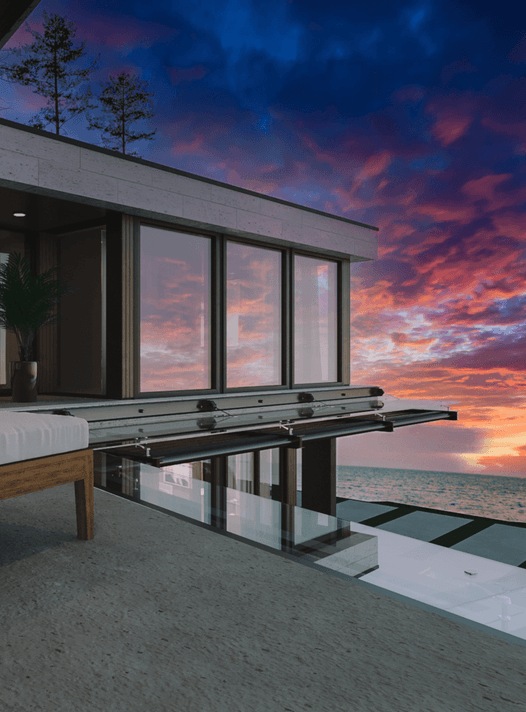Creating Stunning 3D Exterior Renderings: Showcasing Architectural Beauty
A property’s exterior holds the same value as its interior. With 3D rendering technology, you can create stunning exterior renderings to showcase the true architectural beauty of your projects. Whether you want to play with weather patterns or angles, these 7 tips will help you execute your ideas like a pro!
One way to sell a house faster is to focus on its exterior. Many real estate agents only enhance the interiors, not realizing that the outside matters equally.
Through 3D rendering, you can easily add different elements to an architectural area’s exterior. It’s also helpful in highlighting a specific structure or brightening up any part of the house. Not only that, but you can also display the property from different angles and background lighting.

Image from Yousee Studio
3D exterior rendering is an innovative and effective way to show structural beauty to clients. However, the detailing, materials, angles, and textures can make creating exterior renderings challenging. But don’t worry; this guide has got your back.
Let’s check out some helpful tricks to create mind-blowing 3D exterior renderings.
How to Create Stunning Exterior Renderings?
Even if you’re a professional 3D renderer, you might need a few tips to execute the project flawlessly. Here are 7 expert suggestions to help you create the best exterior renderings:
1. Choose Unique Angles
The rule of thumb in standing out from the competitors is being unique. In the case of 3D rendering, it applies to choosing a different, unexpected perspective for your renderings.
Typically, there are two angles that most 3D renderers use: an eye-level view and a helicopter view. Undoubtedly, both give the best results, but you must use something out of the box to capture your client’s eye.
For example, you can show not-so-visible parts of the property as its unique selling point. This could be choosing the view from the balcony, inner garden, or the terrace. Here are some great and unique views for exterior 3D rendering:
- Single House View: For single-family houses, their surrounding landscape, and little visualization of the neighboring buildings
- Street View: For surrounding landscape, cars, roads, and people
- Aerial View: For the whole picture, including the entire block the house is located in
All these angles will give different visualizations to the clients about the house. The best part? Most projects have ample space for you to play with the angles. So, be creative and find the right way to surprise your clients.
2. Play With The Lighting
A perfect light setting can jazz up the entire vibe of your property. The mid-day sun sets the ideal lighting environment to capture natural pictures. But you can go the extra mile and capture the house in the perfect “sun and shadow” position.
However, achieving the correct sun position is usually challenging. Too much sunlight will make the 3D project look washed out, while too little can lead to underexposure.
Shadows, on the other hand, add a realistic touch to your render. But composing them in a way that reflects the true beauty of the perfect requires a lot of effort and time. You must do a lot of trials and errors to see how the project looks in different settings.
For an easy way, you can play with the 3D rendering tech and integrate the golden hour into the render. The Solar North plugin is an excellent way to precisely set the shadow's direction. It lets you position the sun and shadows to support the picture’s composition.
Casting shadows from trees also makes the renders look more realistic. You can project them on the house or ground from an angle set from behind the camera. It will look really lovely!
Early evenings and night settings can also give you the best results. Keep the house well-lit to create a cozy and welcoming environment for the render. Of course, you can also tweak the lighting yourself when editing the 3D renders.
3. Benefit From The Weather
Besides angles, you can also take advantage of weather patterns to create beautiful exterior renderings. This will give your renders an upper hand over the standard clear, full-of-clouds sky pictures.
You have multiple options to benefit from the weather. For instance, the sky looks the prettiest in summer, and the gardens appear at their best in spring. When it comes to fall, who can forget the gorgeous color palette on the trees and leaves?
You can also create a mysterious, foggy render in winter. However, the real question is: how will you choose the correct pattern for different properties? That actually depends on the purpose of the property.
Suppose you’re selling a house that will be used as a summer vacation resort. In that case, you can add some streaks of sunlight to the home and cast shadows of different objects on the ground.
Similarly, add snow on the structure’s top if you’re selling it for winter. Just experiment with various themes and see what works best for specific projects.
4. Select The Best Materials and Textures
Choosing poor materials and textures is the biggest obstacle in creating stunning exterior renderings. They won’t make your renders appear photo-realistic or attractive to the clients. So, spend some time selecting ideal textures and materials to make your renders appear naturally beautiful.
Some materials look good in drawings, but they appear quite different in specific environments. Thus, try several options to see which enhance the overall outlook of your building in various settings.
If you want to save time, you can take help from the Podium Browser material library. It contains high-resolution and flawless textures to give you an easy kickstart.
Whatever you choose, ensure the imported photographs are of high quality. A professional 3D renderer will dig into your selected options to give you more insights.

Image from Yousee Studio
5. Add Details to The Building
In 3D rendering, the designer is in charge of adding and removing whatever they want from the render. If you think a fountain will look great with the building, you can just add it. But of course, do this only if it’s planned to be built at the exact location.
You can also add:
- An attractive statue
- Trees
- A bench with people sitting on it
- Roadside curbs
- Downpipes and drainage
- Details on roof, windows, etc
- Kids playing in the yard
- A dog running after the frisbee
- Flowers to give a touch of color
- Some birds or moving cars to enhance photo-realism
Just boggle your mind and find the most creative ideas to showcase the true architectural beauty of your project.
The best way to decide what to include or exclude from the render depends on your target audience. Are they commercial people, youngsters, or older adults? Choose the elements according to their preferences to sell the house faster.
6. Work With The Existing Surroundings
Surroundings have a major part in creating stunning exterior renderings. While you can easily add anything to your renders, don’t go overboard with non-realistic elements.
Yes, the trees, flower beds, and statues may look beautiful, but what’s the point of including them when they aren’t real? Think of it from the client’s side. Will you like to get impressed by a property that doesn’t look the same in reality? Not exactly.
This practice is also quite helpful for the renderers themselves. They may be asked to make the renders as beautiful as possible. However, once the buyers start calling it manipulation, the designers are told to remove all the fake details.
So, work with the existing surroundings as much as possible. Try to capture some excellent drone shots at the perfect lighting and angles to create realistic renders. Only add greenery and flower beds to the exterior if they will be built afterward.
7. Highlight Your Favorite Exterior Materials
Every property has some details that make it stand out in the market. It could be the entrance, eccentric architectural work, excellent roof setup, a cozy patio, etc. It’s crucial for you to identify and highlight them in your renders.
The ideal way to do so is the close-up. This angle gives a whole new perspective to architectural design. Unlike the typical full-building reveal, the close-up focuses on a specific part of the property.
Highlighting little yet attractive project details helps clients envision the property differently. Close-ups showcase a building’s real essence and help it stand out in the market.

Using Exterior Renderings for Properties: The Best Way to Display Their Architectural Beauty
Exterior renderings showcase a property’s true beauty that often remains undiscovered. 3D rendering allows the designer to play with different lighting, elements, materials, and backgrounds. The goal is to bring out the best in a house and make it look irresistible.
3D rendering doesn’t include any hard and fast rules. It gives enough space to run some trials and errors and see what works best for your rendering projects. As long as you know how to apply the right techniques, your exterior renderings will keep selling houses faster!
Contact us at YouSee Studio for captivating 3D renderings and immersive virtual experiences.
Ray Lisbon is a content writer and the author of this article.


